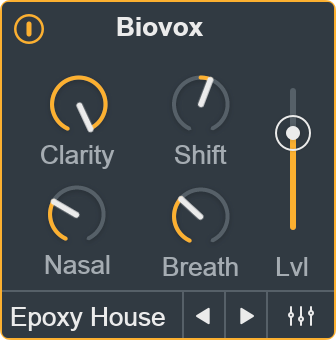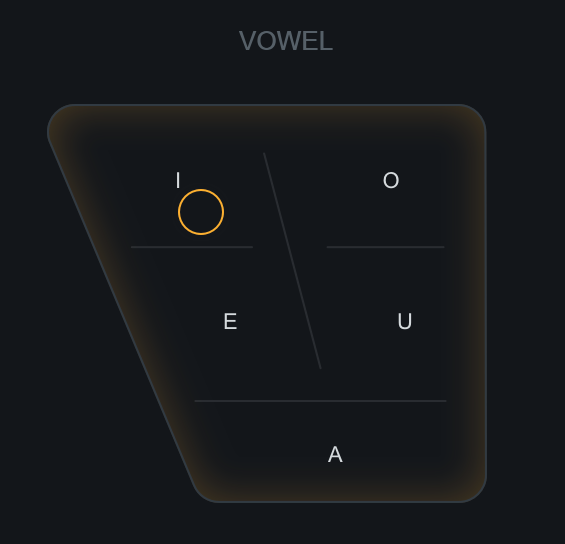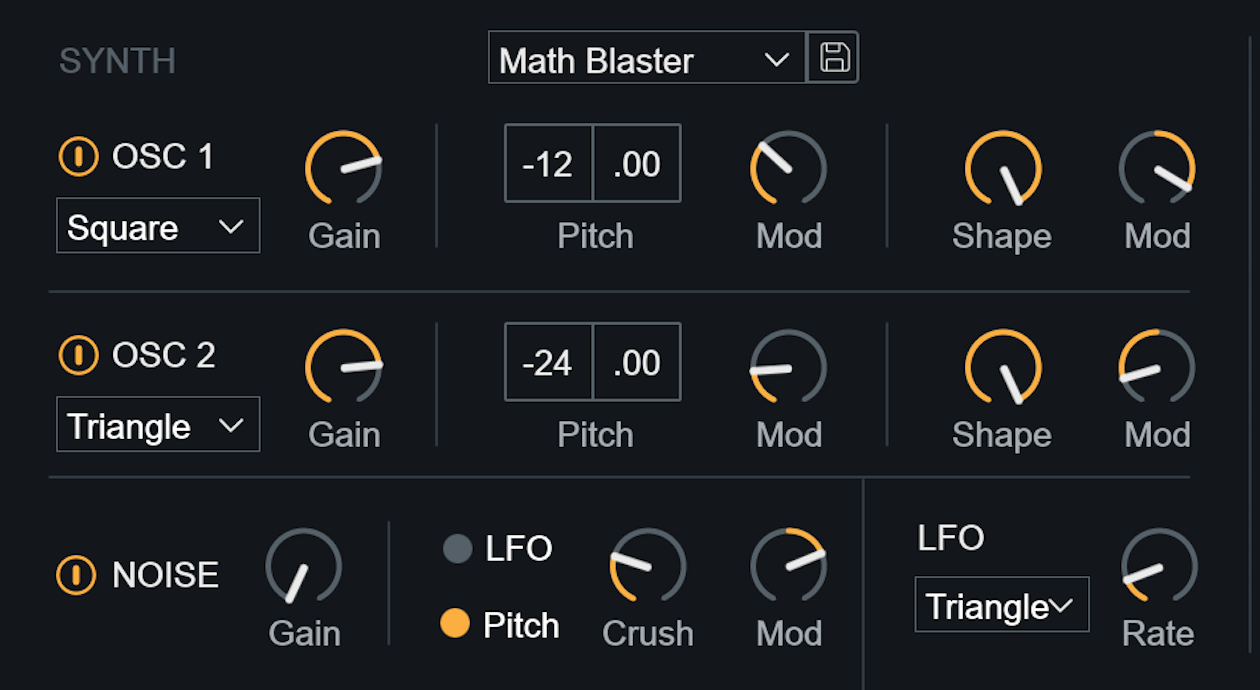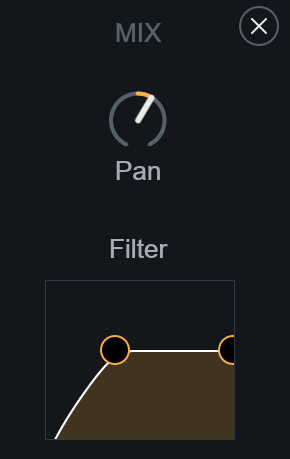Biovox
Overview
Inspired by articulatory synthesis, Biovox offers tools for altering physiological qualities of a vocal. The module estimates a vocal tract shape from the incoming audio and allows you to effectively manipulate the vocal tract length and shape using just a few intuitive controls. In addition to adjusting properties of the vocal tract, you can control and blend vowel sounds using the vowel pad and even impose vocal imperfections such as nasality and breathiness on your vocal. Biovox is an innovative suite of tools for sculpting formants, tone, and the overall vocal aesthetic.
Controls

ENABLE
Enables/disables Biovox module processing.
CLARITY
Controls the amount of filter modulation applied to the signal. At lower values, more of the synth signal is present which allows Biovox to exhibit a playable synth character. Lower values also result in less intelligibility.
SHIFT
Alters vocal tract length to effectively shift the formants of the processed vocal higher or deeper. Positive values result in higher, chipmunk-like sounds. Negative values produce a deep, monster-like sound.
NASAL
Simulates changes to the soft palate to introduce a more nasal quality in the processed vocal.
BREATH
Mixes in a breathy, whisper-like character to the processed audio. At the minimum value, no breathiness is added to the signal. At the maximum value, Biovox will output only the breathy signal.
LVL
Controls the output level of the Biovox module.
Note
- You can also control the Biovox output level by dragging the node labeled ‘B’ that appears in the anemone visualization when the Biovox module is enabled.
SYNTH PRESET SELECTOR

Displays the currently selected synth preset name and allows you to change the synth preset without opening the advanced view. Clicking on the preset name display will open the synth preset list. Clicking on the left and right arrow buttons allows you to quickly load different synth presets. You can modify synth parameters and save new synth presets in the advanced view.
ADVANCED VIEW BUTTON
You can open the Advanced View window by clicking on the mixer button at the bottom of the module’s main panel:

Advanced View
The Biovox Advanced View includes:
- VOWEL: Control and blend vowel sounds.
- SYNTH: Customize synth parameters & save synth presets.
- MIX: Control filtering and panning of the module’s output signal.

Advanced View: Vowel
The Vowel chart is modeled after the official International Phonetic Alphabet Vowel Chart that maps vowels according to a physical location on the tongue. The Vowel chart controller can be used to impart the sound of a particular vowel on the processed signal by moving a node to different locations on the chart.

By default, the node is positioned in the center of the chart, resulting in no vowel blend.
Double-click to reset
Double-clicking on the node will return it to the default position in the center of the chart.
Dragging the node toward the outer boundaries of the chart will impart more of the nearest indicated vowel(s) to the processed audio.
When the node is positioned at an edge of the chart, the vowel blend is at the maximum amount and only the nearest vowel(s) will be audible in the processed output.
Advanced View: Synth
When Auto Mode or MIDI Mode is selected, you can control the oscillators and modulation settings for the notes being played into the Biovox module synth engine.

Sidechain mode disables synth controls
When Sidechain mode is selected, the sidechain input signal replaces the module synth engine as the carrier signal. Synth parameters are disabled in all modules when Sidechain is selected as the global mode.
SYNTH PRESETS
Modules that include synth parameters in the advanced view allow for synth presets to be saved and recalled.

- Default synth presets are loaded when VocalSynth is opened. Each module loads a different synth preset by default. Choosing the “Init” preset from the synth preset dropdown menu will return the module’s synth settings to the default preset values.
- Double-clicking on any knob in the “Synth” section of the advanced view will set the control to a factory default state, rather than resetting the value to the “Init” state.
LOAD PRESETS
Select a preset from the dropdown menu to load the saved synth parameter values in the current module.
Note
You can also quickly change synth presets without opening the advanced view by clicking on the left/right arrow buttons in the module main panel.
SAVE PRESETS
Click on the floppy disk button next to the preset dropdown menu to save a new Synth preset. Type a name in the text field and hit the enter/return key to save the preset.
OSC 1

| NAME | DESCRIPTION |
|---|---|
| ENABLE | Enables/disables Osc 1. |
| WAVEFORM | Selects the waveform shape. |
| GAIN | Adjusts the level of Osc 1. |
| PITCH: Coarse Tune | Tunes Osc 1 in coarse increments. (Semitones) |
| PITCH: Fine Tune | Tunes Osc 1 in fine increments. (Cents) |
| PITCH: MOD | Adjusts the amount of LFO modulation applied to Osc 1’s pitch. |
| SHAPE | Morphs the waveform shape. |
| SHAPE: MOD | Adjusts the amount of LFO modulation applied to the waveform shape. |
The following table outlines how each shape is affected by modulation:
| Shape | Modulation Behavior |
|---|---|
| SAW | Modifies the pulse width of the saw wave. |
| SQUARE | Modifies the pulse width of the square wave. |
| SYNC SAW | This shape simulates two synchronized saw oscillators. Modulating shape will modify the pitch ratio between the two saw oscillators. |
| TRIANGLE | Morphs the triangle wave into a saw wave shape. |
| SAWS | Simulates a swarm of seven saw waves. Modulating shape will modify the detune amount between the saw waves. |
OSC 2

| NAME | DESCRIPTION |
|---|---|
| ENABLE | Enables/disables Osc 2. |
| WAVEFORM | Selects the waveform shape. |
| GAIN | Adjusts the level of Osc 2. |
| PITCH: Coarse Tune | Tunes Osc 2 in coarse increments. (Semitones) |
| PITCH: Fine Tune | Tunes Osc 2 in fine increments. (Cents) |
| PITCH: MOD | Adjusts the amount of LFO modulation applied to Osc 2’s pitch. |
| SHAPE | Morphs the waveform shape. |
| SHAPE: MOD | Adjusts the amount of LFO modulation applied to the waveform shape. |
The following table outlines how each shape is affected by modulation:
| Shape | Modulation Behavior |
|---|---|
| SAW | Modifies the pulse width of the saw wave. |
| SQUARE | Modifies the pulse width of the square wave. |
| SYNC SAW | This shape simulates two synchronized saw oscillators. Modulating shape will modify the pitch ratio between the two saw oscillators. |
| TRIANGLE | Morphs the triangle wave into a saw wave shape. |
| SAWS | Simulates a swarm of seven saw waves. Modulating shape will modify the detune amount between the saw waves. |
NOISE

| NAME | DESCRIPTION |
|---|---|
| ENABLE | Enables/disables the Noise oscillator. |
| GAIN | Adjusts the level of Noise oscillator. |
| LFO/PITCH | Selects the modulation source used by the Crush Mod control. |
| CRUSH | Adjusts the amount of aliasing distortion applied to the noise oscillator. At the maximum value, the Noise oscillator will output white noise. |
| MOD | Adjusts the amount of modulation applied to the Crush parameter. The modulation source is determined by the LFO or Pitch selection to the left of the Crush knob. This Mod parameter allows for bidirectional modulation. |
LFO MOD SOURCE
These parameters define the waveshape and speed of the LFO modulation source. All Mod knobs in the current synth view (except for the Crush Mod control, which can toggle between LFO or Pitch modulation sources) use this LFO as their modulation source.

| NAME | DESCRIPTION |
|---|---|
| SHAPE | Selects the low frequency oscillator waveform shape. |
| RATE | Adjusts the speed of the low frequency oscillator. |
Advanced View: Mix
Adjusts stereo pan position and pass filter controls of the module’s output signal.

PAN
Controls the stereo pan position of the module’s output signal.
FILTER
Adjusts the center frequencies of high-pass and low-pass filters applied to the module’s output signal. Clicking and dragging on a node will adjust the center frequency of that filter. Clicking and dragging in the space below the two nodes will move both nodes at the same time.